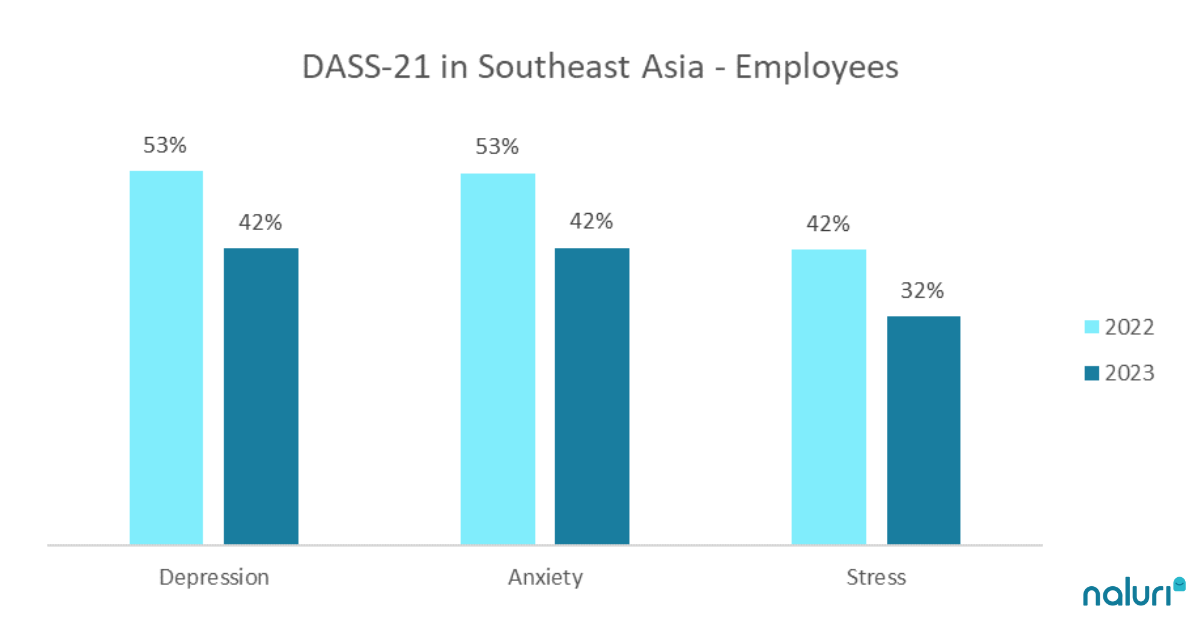A myriad of stressors can trigger mental health issues. There are too many to consider in a single article: internal, external, personal, environmental, etc. In our 2023 Mental Health assessment, respondents admitted that a large majority of their mental health issues were work-related. As any employed person spends equal if not more of their waking hours at work, we can apply the problem statement that bad management creates a hostile workplace environment.
Employed respondents to our survey were asked a series of questions that focused on their work environment. When presented with a question about thriving at work, these were the results, with over 81% of respondents stating that they were only ‘Coping’ within their work environment.
.png?width=1200&height=628&name=DASS-21%20for%20Employees%20%20(3).png)
To provide context for these categories, ‘Struggling’ refers to the state of simply getting by; a new age phrase could equate struggling to ‘quiet quitting’. ‘Thriving’ is when one actively pursues their goals, experiencing a sense of fulfilment with every completed task. ‘Coping’, on the other hand, is like being in an uphill battle, where too much energy is being used to get through the day simply. It’s a slippery slope into ‘Struggling’ but can be circumvented by taking proper preventative measures.
The manager-employee relationship
It’s no secret that managers directly impact employees’ day-to-day, at least within the 9-5. In 2021, the University of South Australia (UniSA) conducted a comprehensive study on Workplace Psychological Health and Safety. The study focused on the intricate dynamics between workplace mental health and management practices. The findings concluded our problem statement that inadequate management practices, misaligned priorities, and conflicting values create a psychologically stressful work environment for any employee.
When we spoke to our Health Assessment respondents, we asked employed individuals to rate how they felt and functioned in their workplace. Out of the multiple dimensions of the survey, respondent results identified three key dimensions where employees feel least favourable regarding their workplace. From highest to lowest;
1. Compensation/Salary
2. Workplace treatment
3. Psychological Safety at Work
.png?width=1200&height=628&name=DASS-21%20for%20Employees%20%20(4).png)
The lowest distribution rank indicates that fewer employees agreed with the statement presented. Only 20% of the respondents are happy with their compensation and feel safe voicing their opinion, leaving another 80% in a negative space.
Understanding managerial influence.
We’ve already established a direct link between a manager and the mental health status of an employee. Because of this, we could argue that managers have a more significant influence over a person’s mental health than their spouse, family or therapist. A report by The Workforce Institute at UKG confirmed this notion in a study conducted in 2023.
- 69% of respondents stated that their managers had more impact on their mental health compared to their spouse
- 51% stated it was more impact than their doctor
- 41% said it was more significant than their therapist
Managers are responsible for a team’s workload, OKRs or expectations, and feedback loop. Being accountable for these building blocks sometimes gives managerial teams tunnel vision. Allowing for neglect and toxicity to seep in when managers forget they are also directly responsible for supporting the team and carrying empathy to foster growth instead of declining mental health.
Signs of Manager-Induced Stress and Anxiety.
Naluri’s 2023 Mental Health Assessment contained feedback from respondents on what factors affected their mental health. Many indicated that work-related scenarios affected them most, and this is what we could conclude from conversations with the coaches.
- Difficulties in managing expectations with managers lead to issues in the working relationship
- Lack of support, direction and guidance from managers
- Concerns regarding performance at work that impacts the relationship with manager
- Competitive working environment, leading to a toxic work environment
Ironically, Google provided an apt solution. Google’s Project Aristotle was a study that identified the key factors that make a successful team. It began by reviewing a half-century of academic studies that described the inner workings of a team. Google then researched close to 180 teams from all over the company.
Specific teams identified as highly influential by Google consisted of individuals who were friends and engaged in social activities outside of work—conversely, some successful teams comprised members who had little to no interaction outside of the workplace.
After studying more than a hundred groups for over a year, researchers from Project Aristotle found that the key to improving Google’s teams was understanding and changing group norms.
The 5 Key Dynamics of a Successful Team:
- Psychological Safety: Team members feel safe to take risks and be vulnerable in front of each other.
- Dependability: Team members finish things on time and meet Google’s high bar for excellence.
- Structure & Clarity: Teams have clear roles, plans, and goals.
- Meaning: Work is personally important to team members.
Improvements that Employers can make
Organisations can consider several practical applications to mitigate the risks mental health issues can pose to a team or company. These are some of the more practical applications you could consider.
1. Investing in a comprehensive Employee Assistant Programme (EAP)
2. Engaging with digital mental health tools
3. Conducting leadership and management workshops
4. Consider flexible work hours and other benefits to boost morale
5. Offer other perks if a compensation workaround is not feasible.
Something as simple as a weekly yoga class or a monthly lunch budget for teams to socialise can create a positive workplace.
Why organisations should invest in securing employee mental health?
Organisations should prioritise investing in employee mental health for several reasons. Firstly, it directly correlates with enhanced productivity, as mentally healthy employees tend to be more focused and efficient. A supportive and inclusive environment improves organisational culture, leading to higher morale and job satisfaction. Proactive mental health initiatives also help reduce healthcare costs related to untreated issues and absenteeism. Prioritising employee wellbeing aids in attracting and retaining talent, demonstrating a commitment to their holistic welfare, which job seekers increasingly value.
Moreover, it is a risk mitigation strategy, preventing workplace conflicts and burnout. Investing in mental health aligns with social responsibility, reinforcing the resilience and effectiveness of the organisation. By promoting mental health, organisations create a positive reputation, attracting socially conscious customers and investors. Ultimately, prioritising employee mental health fosters a caring and responsible workplace culture that values the wellbeing of all members.
In our last article, Naluri’s dataset measuring mental health in Southeast Asia concluded that mental health is improving in many regions. Even amongst employed individuals versus students, retirees and unemployed people, the statistics resonate, showing an improved state of mental health in 2023 compared to 2022.

Organisations must foster a positive workplace. By investing in mental health support and resources, organisations can create an environment where employees feel valued and motivated, allowing them to thrive personally and professionally. Not only will it help improve the bottom line of a business, but it will contribute to a healthier individual. Check out Naluri’s suite of products and services to learn more!
